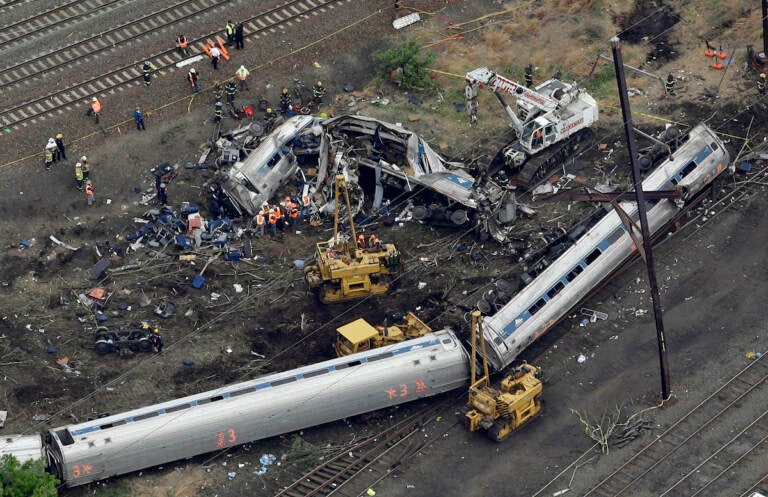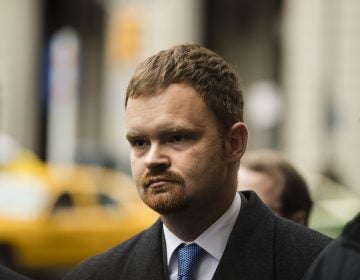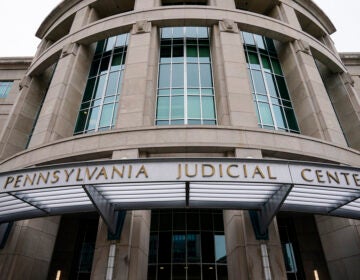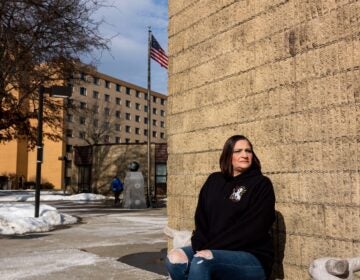First day of trial for Amtrak engineer focuses on key question: crime or terrible accident?
Prosecutors and defense attorneys laid out opposing perspectives on the line between an accident and a crime in the case of Brandon Bostian.

In this May 13, 2015, file photo, emergency personnel work near the wreckage of a New York City-bound Amtrak passenger train following a derailment that killed eight people and injured about 200 others in Philadelphia. (AP Photo/Patrick Semansky, File)
Was a tragic derailment a “terrible accident” or did the train engineer recklessly fail to do his job at a dangerous point in his route?
On Friday morning, prosecutors and defense attorneys laid out opposing perspectives on the line between an accident and a crime in the case of Brandon Bostian, the train engineer onboard when Amtrak train No. 188 derailed in Philadelphia in 2015.
Both sides agree on the facts of the derailment itself. Bostian’s train departed 30th Street Station shortly after 9 p.m on May 12. It picked up speed as it headed into a tight curve near Frankford Junction, reaching 106 mph when the speed limit was 50 mph. Bostian braked, but the train derailed seconds later, killing 8 people and sending nearly 200 to the hospital.
Pennsylvania courts repeatedly disagreed as to whether the engineer’s involvement should go to trial, but a 2020 Pennsylvania Superior Court decision cleared the way for a criminal case to proceed.
Bostian faces one count of causing catastrophe, eight counts of involuntary manslaughter, and 246 of recklessly endangering another person. He waived his formal arraignment and pleaded not guilty to all charges on Friday morning.
Prosecutors laid out Bostian’s extensive training and expertise, arguing that it amounted to an obligation not to make a mistake. In order to hold his position, “he’s got to show that he’s got the visual characteristics of that route memorized,” said senior deputy attorney general Christopher Phillips. That training is mandatory because “all those people are in your hands, every time you go to work,” he continued.
The prosecution also described Bostian’s actions after the derailment as evidence that he was conscious of being at “the most dangerous curve” in his route.
After getting tossed from his cabin, Bostian was wandering around the scene when he encountered passenger Blair Berman. Berman asked to use his phone, and Bostian eventually agreed. He was able to tell her where in the track they were, even though he would later be confused about his location when taken to the hospital to treat a concussion.
Knowing where he was, and knowing his main job was to “control the speed of the train,” puts Bostian’s behavior over the line, according to prosecutors.
“The law recognizes that sometimes in an accident the conduct is so reckless, so negligent, that it becomes a crime,” said Phillips.
Defense attorney Brian McMonagle took that same expertise and argued it showed Bostian had a history of being a safe, conscientious engineer who would not consciously risk his passengers’ lives. He pointed to a National Transportation Safety Board report which had drug tested Bostian, examined his phone, and his past performance, and did not find that he had done anything to knowingly inhibit his performance.
“Accidents become crimes when you’re aware of, but consciously disregard, the risks,” said McMonagle.
Instead, defense counsel homed in on reports from just before the derailment that a nearby SEPTA train had been struck by an object, shattering the glass of that engineer’s cabin.
“[Bostian] doesn’t know if it was bullets or rocks or what. And he’s worried, because he knows the engineer has been struck,” said McMonagle. Bostian tuned into radio reports about the attack and trespassers on the track shortly before the derailment.
Instead of recklessly disregarding the speed limit, Bostian was worried about an attack and had confused two similar stretches of track, both with right curves, said McMonagle. The speed limit rises to 100 mph after the second curve, but Bostian accelerated to that degree after the first.
“When a crime occurs, it shatters lives just like glass. And it can also continue to shatter them well after,” said McMonagle. He argued that the people who had thrown rocks at that train were the ones who acted criminally, but Bostian is the one on the hook for their actions.
The derailment was a “terrible accident caused by somebody else, and not a crime caused by him,” said defense counsel.
To support their argument, the commonwealth called three law enforcement officers who had been at the scene that night, and used their recollections and police photographs to illustrate the destruction. A forensic pathologist also walked through the injuries suffered by those who died.
Blair Berman then described the events immediately before and after the derailment. As the train lost control, she said, “I felt my body tilt to the right and it kept tilting more and more.” Berman blacked out, and when she came to, there were three people on top of her back leg.
She crawled to a tree and hoisted herself up on her other leg. “I had blood dripping down my face and my adrenaline was through the roof,” she said.
Berman began calling for help, and eventually saw a light approach. It was Bostian with his phone. After she asked him three or four times, he let her borrow it to call her father. When her dad asked where she was, Bostian told her they were near Frankford Junction but did not identify himself.
The day ended with testimony from Joseph Curran, the Amtrak dispatcher for the stretch where the derailment occurred. It’s “not uncommon” to hear reports of rocks thrown at trains, he said.
But under cross examination, he said the fact that another train’s windshield had shattered was unusual. “That would be the first,” said Curran.

Show your support for local public media
WHYY is your source for fact-based, in-depth journalism and information. As a nonprofit organization, we rely on financial support from readers like you. Please give today.






